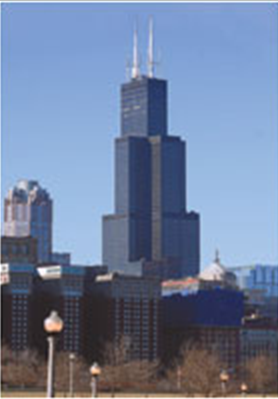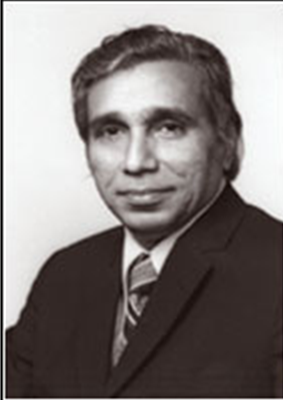Dr. Fazlur Rahman Khan
This is a collection of articles archived for the excellence of their content. Readers will be able to edit existing articles and post new articles directly |
Dr. Fazlur Rahman Khan
(1929-1982),
The master of skyscrapers
By Dr. Ahmed S. Khan
April 3, 2008 marked the 79thh anniversary of birth of Dr. Fazlur Rahman Khan (1929-1982), one of the greatest structural engineers of the twentieth century. Today, in the 21st century, 100-plus story skyscrapers are popping up in the major cities around the globe. Clusters of skyscrapers not only offer an exquisite and modern skyline but also reflect the economic prosperity of a city.
Until 1960s the construction of a 100-plus- storey building was not viable because of technological challenges and difficulties involved in dealing with the forces of gravity and wind. It also required colossal financial investment. But then Dr. Khan emerged on the horizon of structural engineering, and his innovative ideas and techniques enabled architects and structural engineers to design and build tall skyscrapers.
Dr. Khan revolutionised the construction of tall buildings by inventing ‘framed tube’, ‘braced tube’ and ‘bundled tube’ structural systems, which made it possible to construct the 100-story John Hancock Centre and the 110-Story Sears Tower in Chicago (a building so tall that it needed Federal Aviation Administration approval before the construction could commence) using a minimum amount of steel.
Dr. Khan’s structural system inventions play a fundamental role in the design of modern high rise buildings. His efforts were not only limited to structural engineering but also played an important role in the form and architecture of the buildings he worked on.
Dr. Khan’s contributions and innovative approach to tall building design and attention to aesthetic details to the field have been so significant that he has been called the ‘Einstein of structural engineering’ and the ‘Father of the modern skyscraper’. For his contributions to the field, he has not only received the highest international awards for engineering but also been recognised for his architectural creativity.
To honour this world-famous engineer, a chair has been established in Dr. Khan’s name at Lehigh University. The Structural Engineers Association, Illinois, has installed a Khan Sculpture in Sears Tower; and the city of Chicago has named one of the streets in downtown Chicago ‘Fazlur R. Khan Way’. Had there been a Nobel Prize in engineering, he surely would have won it!
Dr. Khan was born on April 3, 1929, in Dhaka. His father, Abdur Rehman Khan, was a prominent educator and author. He studied engineering at Bengal Engineering College Calcutta, India, and moved to Dhaka after the creation of East Pakistan. He earned his Bachelor of Science degree in 1951, from the University of Dhaka.
In 1952, Fulbright and Government of Pakistan scholarships enabled him to travel to the United States to pursue graduate studies at University of Illinois, Urbana/Champaign. He was a brilliant student; he completed enough academic credits by taking courses in both civil engineering and theoretical and applied mechanics simultaneously to get two Master’s degrees in two years. He completed his Ph.D. thesis in the very short time of one year after that.
In 1955, Dr. Khan joined the Chicago office of Skidmore, Owens & Merrill (SOM), one of the largest and renowned architectural firms in the world. In 1957, he went home to Pakistan and worked as a technical adviser to the chief engineer at Karachi Development Authority (KDA). His seniors at KDA failed to tap into his technical genius as he was forced to do administrative tasks for three years rather than design work. Dejected and disappointed by his tenure at KDA, he returned to Chicago and joined SOM once again.
Over the next two decades, Dr. Khan’s innovative contributions to structural engineering enabled SOM to become a leader in the development of tall buildings.
Dr. Khan passed away on March 27, 1982, in Saudi Arabia while he was working on the construction of Hajj Terminal at Jeddah airport and the design of a university campus in Mecca. Mourning his death, the prominent technical publication Engineering News-Record paid tributes to him by observing: “The consoling facts are that his structures will stand for years, and that his ideas will never die.”
Twenty-six years after his death, publication of two books has regenerated interest in the life and accomplishments of Dr. Khan. The first book, Art of the Skyscraper: The Genius of Fazlur Khan written by Professor Dr. Mir Ali, Professor of Architectural Structures at the University of Illinois at Urbana-Champaign, offers a vivid portrait of Dr. Khan’s accomplishments. The second book, Engineering Architecture: the Vision of Fazlur R. Khan, written by Dr. R. Khan’s daughter Yasmin Sabina Khan Byron, a structural engineer, presents an account her father’s design projects within the context of his personal beliefs, and the social settings of the time.
Dr. Khan was far more than an innovative structural engineer; he was also a philosopher, a thinker and a humanitarian. He had a keen interest in the people, art and music and literature. In 1972, he said, “The technical man must not be lost in his own technology; he must be able to appreciate life, and life is art, drama, music, and most importantly, people.”
Dr. Fazlur Rahman Khan has left behind a legacy of tall building design. In his designs, he believed in logic, truth, objectivity, and rationality. His innovative ideas are present in form of tall buildings in the major cities of the world today. One Magnificent Mile and Onterie Center, John Hancock Centre, the Sears Tower, all in Chicago; One Shell Plaza, Houston, Solar Telescope, Arizona, U.S. Air Force Academy, Colorado, World Trade Centre, Hong Kong; and the Hajj Terminal, Jeddah, are some of his best known completed projects.
Dr. Ahmed S. Khan is a Professor in the EET Department at DeVry University, Addison, Illinois, USA.
Top: Solar Telescope, Arizona
Top left: Sears Tower, Chicago
Left: John Hancock Centre, Chicago


